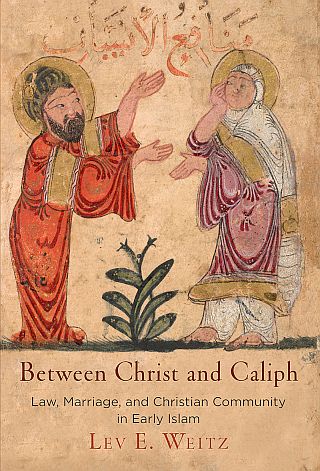
The University of Pennsylvania Press has just released Between Christ and Caliph: Law, Marriage, and Christian Community by Lev Weitz, Assistant Professor of History.
Dr. Weitz describes the book as “a study of how Muslims and Christians, as well as Jews and others, interacted to create the societies of the medieval Middle East.” While we often imagine the Middle East as a straightforwardly Islamic region, its makeup was never so simple. In the early history of Islam, it was extraordinarily religiously diverse. Peoples of many faiths—Sunnis, Shiites, Christians, Jews, and others—interacted with each other in city streets, marketplaces, and even shared households, all under the rule of the Islamic caliphate.
Between Christ and Caliph examines this multiconfessional society of early Islam through the lens of shifting marital practices of Syriac Christian communities, the Aramaic-speaking Christians of Iraq and Syria. The Islamic milieu influenced many aspects of Christian social life. In response, Syriac Christian bishops created new laws to regulate marriage, inheritance, and the family. They banned polygamy, required priests to bless Christian marriages, and restricted marriage between cousins, seeking ultimately to identify themselves as a community distinct from their Muslim neighbors while still maintaining a place in the Islamic social order. By binding household life to religious identity, Syriac Christians developed the social distinctions between religious communities that came to define the medieval Islamic Middle East.
Ultimately, Between Christ and Caliph argues that interreligious negotiations such as these lie at the heart of the history of medieval Islam. “I wanted to tell a story of how much of what we consider characteristic of the Middle East emerged from the interactions between different religions. Even when relations were fraught, they were never isolated in their own bubbles,” Dr. Weitz said. “The increasing tendencies toward religious and national uniformity in the region are more a product of the last two centuries than of Islam’s earlier history.”
Dr. Weitz is also enthusiastic about the prospect of introducing to readers the Christian traditions of the Middle East with which they may not be familiar. “The Middle Eastern churches are as significant a part of global Christianity as Roman Catholicism or Greek Orthodoxy, but the depth of their history isn’t widely known.” Dr. Weitz hopes that the historical individuals who appear throughout the book—such as the slave concubines of a rich, polygamous Christian doctor in medieval Baghdad, or the Iraqi deacon trying to figure out if a parishioner was allowed to marry her cousin—will add to readers’ appreciation of the human diversity of both the Middle East and the Christian heritage.
Between Christ and Caliph is available through the University of Pennsylvania Press’s online store at a 20% discount with the promotional code PJ28, as well as from multiple other retailers.
